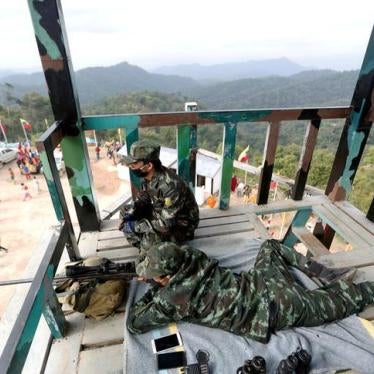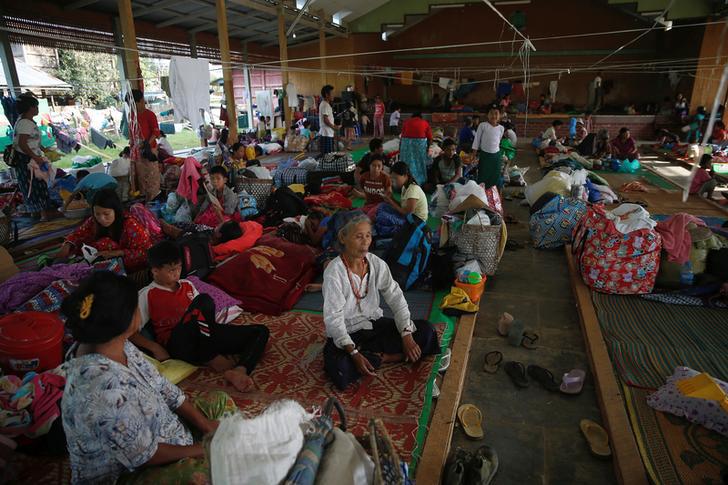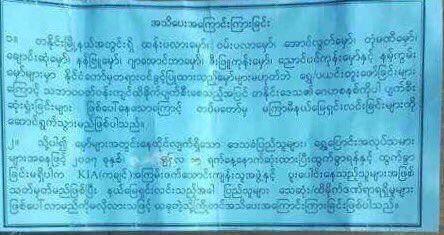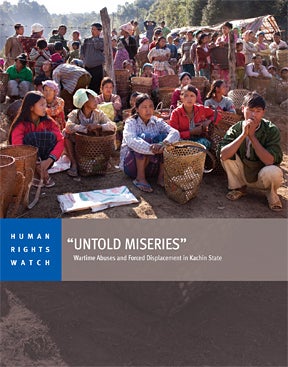All Parties Should Provide Protection, Safe Evacuation
People displaced in the conflict between the Burmese military and the Kachin Independence Army are seen at a church in Tanai Township, Kachin State, June 14, 2017.
© 2017 Reuters
(Rangoon) – The Burmese military and Kachin Independence Army (KIA) should provide civilians with safe exit routes from conflict areas and ensure that civilians are properly distinguished from combatants, Human Rights Watch said today.
On June 3, 2017, fighting erupted in Tanai Township in western Kachin State between the Burmese army, known as the Tatmadaw, and the KIA. On June 4, mortars landed near a village in the township, injuring a woman and her two daughters, aid groups reported. Human Rights Watch was unable to establish who was responsible for the attack. On June 5, Tatmadaw helicopters dropped leaflets over Tanai Township, the aid groups said, ordering local residents to evacuate specific areas by June 15, or they would be “considered as cooperating with the terrorist group KIA,” and warning that the Tatmadaw would soon “clear the area.”
“Military operations must be conducted by all parties in a way that respects international law and protects the vulnerable civilians in Tanai Township,” said Brad Adams, Asia director. “Parties to a conflict can’t declare people terrorists or combatants simply because they refused to leave their homes.”
An escalation of violence between the Tatmadaw and the KIA followed the June 3 fighting. That has caused local residents from at least three surrounding towns to seek shelter in the town of Tanai, but the army has blocked most routes out of surrounding villages, aid groups told Human Rights Watch. Many villagers and migrant workers trapped by the fighting have been forced to walk long distances as they cannot afford the high rates that operators of motorboats or cars charge to evacuate them.
Aid groups have only recently gained access to villagers north of Tanai to assist with transportation. As of June 14, four of the five main roads leading to Tanai town remained blocked, the aid groups said. The total number of those displaced by the fighting could not be confirmed.
Under customary international humanitarian law, parties to the conflict should take all feasible steps to remove civilians from the vicinity of military objects. All parties are also obligated to facilitate rapid and unimpeded humanitarian assistance to all civilians in need.
A copy of the leaflet dropped by Tatmadaw helicopters on June 5, 2017, over Tanai Township, Kachin State, ordering local residents to evacuate specific areas by June 15 or be “considered as cooperating with the terrorist group KIA.” The leaflet warns that the Tatmadaw would soon “clear the area.”
Human Rights Watch obtained a copy of the warning leaflet dropped on June 5, which identified 10 mining sites it claimed were illegal and were destroying the environment. The warnings did not specify where the “local residents and migrant workers” should seek safety. It is not clear how many people in Tanai Township were notified or how many received the warnings, but images of the warnings were spread on social media. Aid groups also confirmed that villagers arriving in Tanai town had received the warnings. The warning said that local people and migrant workers living in the identified areas must evacuate by June 15, and “the people who don’t leave will be considered as cooperating with the terrorist group KIA (Kachin).” It said that the warnings were delivered to help prevent civilian casualties.
Under customary international humanitarian law, parties to a conflict must, where circumstances permit, provide effective advance warnings of attacks that may affect the civilian population. To be “effective,” a warning must take into account the amount of advance notice and the ability of civilians to flee the area to safety.
Civilians who do not evacuate following warnings are still fully protected by law. Even after effective warnings have been given, attacking forces may not assume that civilians have evacuated, and must remain aware of the presence of civilians in an area. The attacker remains obligated to distinguish between military targets and civilians or civilian objects, and must still take all feasible precautions to avoid loss of civilian life and property. It is a violation of the laws of war to presume that anyone who remains in an area following warnings to flee is a legitimate military target. Warring parties may not cause forced displacement by threatening civilians with deliberate harm if they did not heed warnings.
The renewed fighting in Kachin State comes on the heels of the six-year anniversary of the resumption of active hostilities between the Tatmadaw and the KIA. On June 9, 2011, a major army offensive on KIA-controlled territories broke a 17-year ceasefire. Since the resumption of fighting, Human Rights Watch has documented numerous violations of human rights and humanitarian law by both the Tatmadaw and the KIA. Tatmadaw abuses include torture, forced labor, attacks on civilians, extrajudicial killings, destruction of property, and the use of child soldiers. The KIA was found to have used child soldiers and landmines. A June 14 report by Amnesty International details numerous abuses by both the Tatmadaw and the KIA, as well as other ethnic armed groups, in both Kachin and Shan States over the last seven months.
“While it is important that the Tatmadaw issued warnings, its threats to treat the civilians as combatants because they choose to stay in their homes violates the principle of civilian immunity,” Adams said. “It’s a tactic that terrorizes, not protects.”
https://www.hrw.org/news/2017/06/14/burma-warnings-not-free-pass-harm-civilians
MORE READING
 News Release
News ReleaseBurma: Protect Civilians in Northern Fighting
 News Release
News ReleaseBurma: Halt Indiscriminate Attacks in Kachin State




















